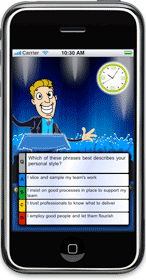Six in ten people (more than 4 billion individuals) around the world are carrying a powerful computing device in their pockets and purses. They don’t realize it, but today’s mobile phones have the computing power of a personal computer from the mid-nineties, while consuming a fraction of the energy and are made at significantly lower cost.
In India, the mobile phone has revolutionized communication and India is now one of the fastest growing markets for mobile phone services, with growing usage and increasing penetration. According to TRAI, there are 286 million wireless subscribers in India, June 2008, of which 76 million were capable of accessing data services. The increasing ubiquity of the mobile phone begs for it to be used as a learning tool. It would be a shame if we were unable to leverage it to improve socio-economic conditions in our vast population.
Mobile phones are not just communications devices sparking new modalities of interaction between people; they are also particularly useful computers that fit in your pocket, are always with you, and are nearly always on. Like all communication and computing devices, mobile phones can be used to learn. The content delivered would depend on the capabilities (features) of the device accessing it.
There are many kinds of learning and many processes that people use to learn, but among the most frequent, time-tested, and effective of these are listening, observing, imitating, questioning, reflecting, trying, estimating, predicting, speculating, and practicing. All of these learning processes can be supported through mobile phones. In addition, cell phones complement the short-attention, casual, multitasking style of today’s young learners.
| Viewed simply; phones are capable of: | |
| 1. | Voice — These are the most basic phones, are still prevalent though being rapidly replaced. Such phones with voice only technology can be used to learn languages, literature, public speaking, writing, storytelling, and history amongst a whole range of topics. We’ve known that voice based learning works for millennia now. |
| 2. | SMS — Widely used in India, literally billions of short text messages are sent over the phone networks. These messages can be written quickly and offer enormous learning opportunities. SMS can be used to provide just in time information of almost any type, like reminders. (e.g., someone undergoing a formal mentoring process) SMS can be used for informational quizzes. There are also innovative games based around SMS that have strong learning potential. |
| 3. | Graphic Displays — Almost every mobile phone has a graphic display, even if it just shows signal and battery strength. Most phones today have far more graphic power and are able to display words, pictures and animation. This comes as an advantage to trivia geeks who play word unscrambler and other trivia games, or even for bookstagrammers who read frequently. Such screens also allow for meaningful amounts of text to be displayed, supporting rapid serial presentation of context-appropriate information. You can use this type of displays for almost any sort of learning. Eventually these displays will render content that is today rendered on personal computers. |
| 4. | Downloadable programs — With mobile phones that have memories, and can accept and install downloaded programs an entire new learning space is opened up on the phone. Almost any sort of learning content and interaction technology can be delivered to the phone using this method. |
| 5. | Mobile Internet Browsers — Internet browsers are now built into an increasing number of phones, especially those that take advantage of 3G or enhanced data networks such as GPRS. Having a browser on the phone opens up all the learning resources available on the web, including Google, LMS applications, typical eLearning courseware and other tools/applications. |
Without proper research its hard to arrive at the worth of the m-learning market in India, any projection is unfounded; and is also due to the improbability of being able to predict the rate of technological (read network) adoption and penetration. However, empirically, we are seeing an increasing interest in mLearning. This example of mobile learning shows an application designed for women in villages without access to proper prenatal care.
Similar to India, it’s hard to quantify adoption in more developed markets. It’s well known that Asia and Europe are far ahead in terms of mLearning adoption compared to the North American market. The US market for Mobile Learning products and services is growing at a five-year compound annual growth rate (CAGR) of 21.7% and revenues reached $538 million in 2007. It would be fair to say that revenues in Europe and Asia will be equal to if not greater than the North American market.
Almost every sector will benefit from the use of m-learning, however we feel three primary areas that will feel the biggest impact: Education , Agriculture and Healthcare
Additionally, rural communities will benefit tremendously not just from mLearning, but the mobile technology as a whole. Mobile devices are far cheaper than personal computers and do not depend on a continuous power supply to function.
There is a definite appeal in gaming for learning using mobile phones. Currently, several companies are experimenting with game-based learning technology for mobiles. However, the feasibility of such an approach depends on the cost of development and deployment of such applications, which are quite high at this time. With increasingly capable hardware and connectivity available and dropping costs, it’s only a matter of time before learning games on mobile become commonplace.
In the future, we will see mobile phones, computers and various other computing/media devices (iPods, Digital Cameras, PDAs, etc.) we use converge into a single personal mobile computing device. At such a time, the differentiation between eLearning and mLearning will cease to exist; all learning will be electronic and mobile.



















